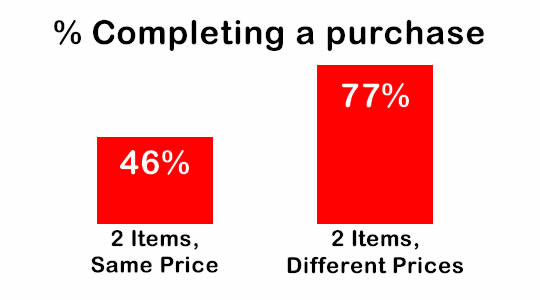Is This Common Pricing Mistake Costing You Sales?

If you have an ecommerce site, how often do customers visit – often after a costly paid click – and end up leaving without buying? Are abandoned shopping carts all too common? Or, if your customers visit your retail store, how often do you see them compare several items, only to buy none of them and move on? If you stock similar items (and who doesn’t?), the problem could be your pricing.
A new study by researchers from Singapore and Yale revealed a pricing surprise: if two similar items were priced the same, subjects were much less likely to buy one than if their prices were slightly different!
This may seem counter-intuitive. Wouldn’t different prices just add confusion to the decision process? In fact, a tiny price difference seems to make the similar products more alike, and increases the probability that a decision will be made and not deferred.
In one experiment, the researchers presented two groups of subjects with a choice. They gave all subjects a dollar with the option to buy gum or keep the money. Two similar types of gum were offered. One group saw both gum options priced at 63 cents, while the other saw one gum priced at 62 cents and the other at 64. This trivial difference caused 77% of the second group to buy vs. just 46% for the first group – a 67% boost!
In retail settings, similar products may be offered at the same price. But, rather than simplifying the choice for the consumer, doing so may actually increase the probability that the consumer will buy nothing at all.
This doesn’t mean that a retailer should attempt to individually price every size and color for one sweater design, for example. That would be a logistical nightmare and most consumers don’t agonize over which size they need. But, if two sweaters are similar except for, say, one having a crew neck and the other a v-neck, pricing them a few cents apart might help sell more total units.
Give this a try and share your results! I hope at least one Neuromarketing reader with a busy ecommerce site does so – this would be a fairly trivial A/B test, and it would be great to show the effect in a real-world setting. Leave a comment with your thoughts or findings!
